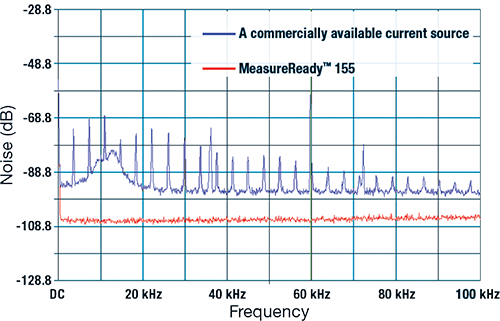Lower noise for better measurements
No filters needed
Characterization of sensitive new electronic materials often requires both AC and DC excitation signals, with source noise directly impacting measurement sensitivity.
To ensure high performance and functionality in an AC source, typically DC noise performance is compromised (and vice versa) because the filtering most often used to quiet DC noise also dampens AC signals and affects stepping and pulse width modulation. The 155 was purposefully engineered to achieve low-noise levels without additional filtering, enabling exceptional output performance in both DC and AC modes.
In side-by-side tests, the 155 current voltage source demonstrated a cleaner output signal with a lower noise floor than other commercial sources costing far more. That’s a key reason why the 155 provides a solid foundation for researchers performing I/V curve, Hall effect, resistance, resistivity, and other fundamental measurements of novel materials and early-stage devices.
Uncompromised noise performance
The 155 generates just 200 nV RMS (1 µV p-p) of low frequency (<10 Hz) noise and 9 µV RMS of higher frequency (10 Hz to 100 kHz) noise in the 10 mV range. With a programming resolution of 100 nV, the 155 is ideal when a very clean, ultra-low voltage output is required. For low current signals, the 155 precision source is equally capable —just 7 pA RMS of low frequency noise and a very low 1 nA RMS of higher frequency noise in the 1 µA range, with a 10 pA setting resolution.


Comparison of the MeasureReady 155 (red) to another commercial current source (blue) at 100 mA into a 100 Ω resistor. The noise (in dB) is shown as a function of frequency from DC to 100 kHz. The noise spectrum of the blue trace clearly shows harmonics occurring at ~5 kHz intervals. Adding this type of noise to a measurement will require a larger number of data points to be averaged.




